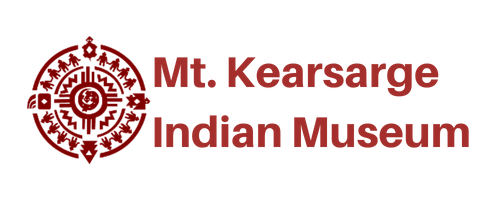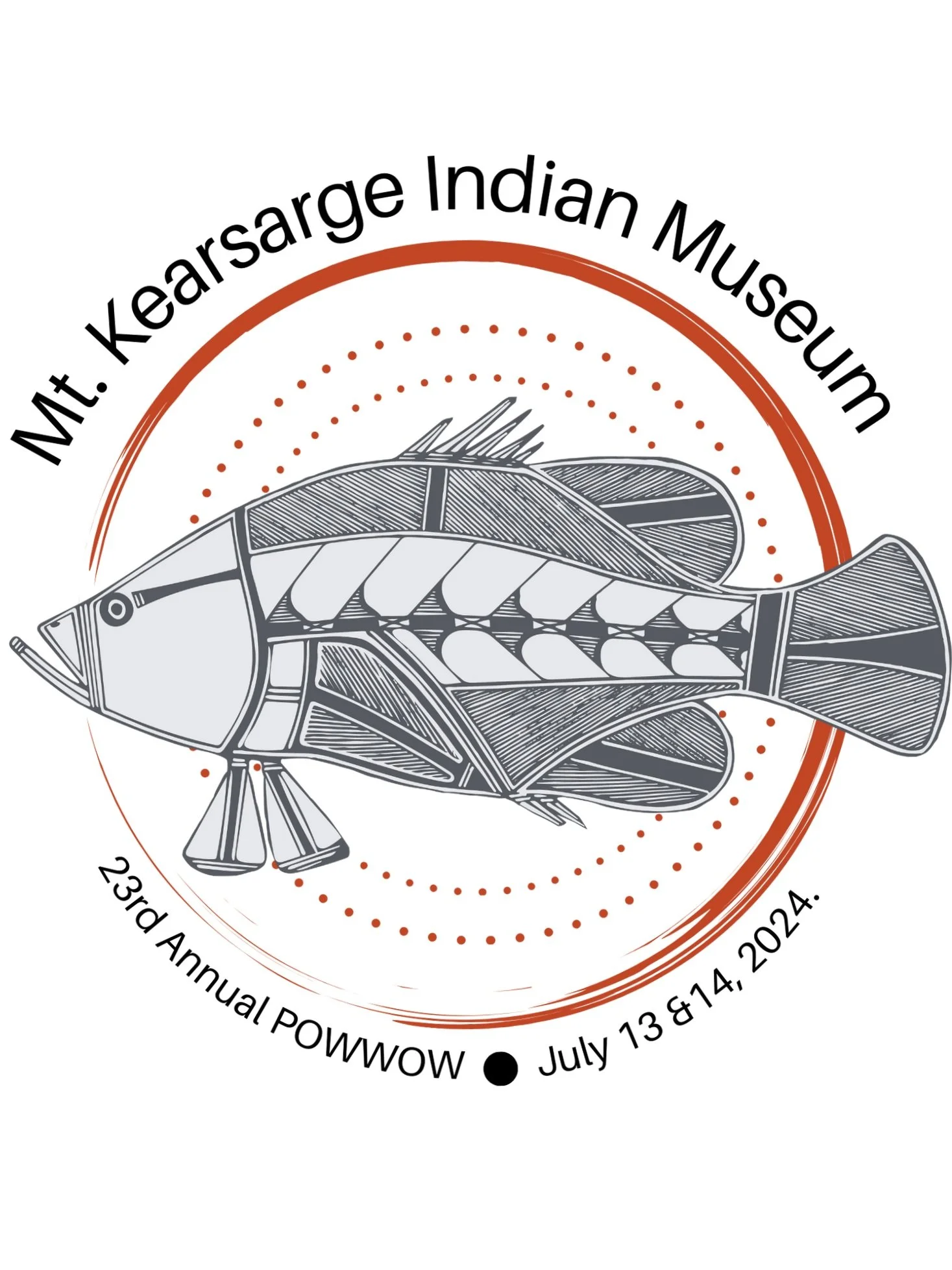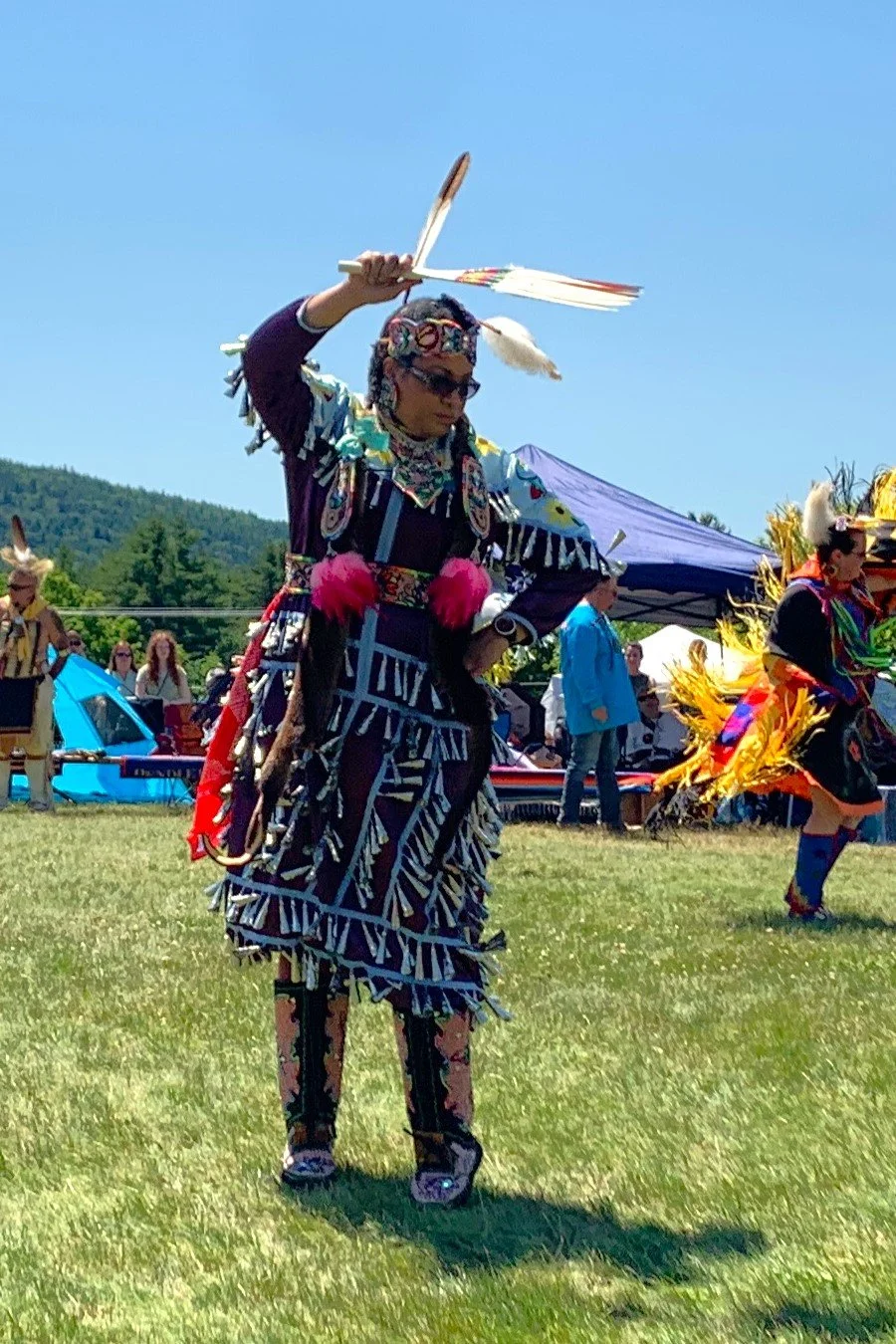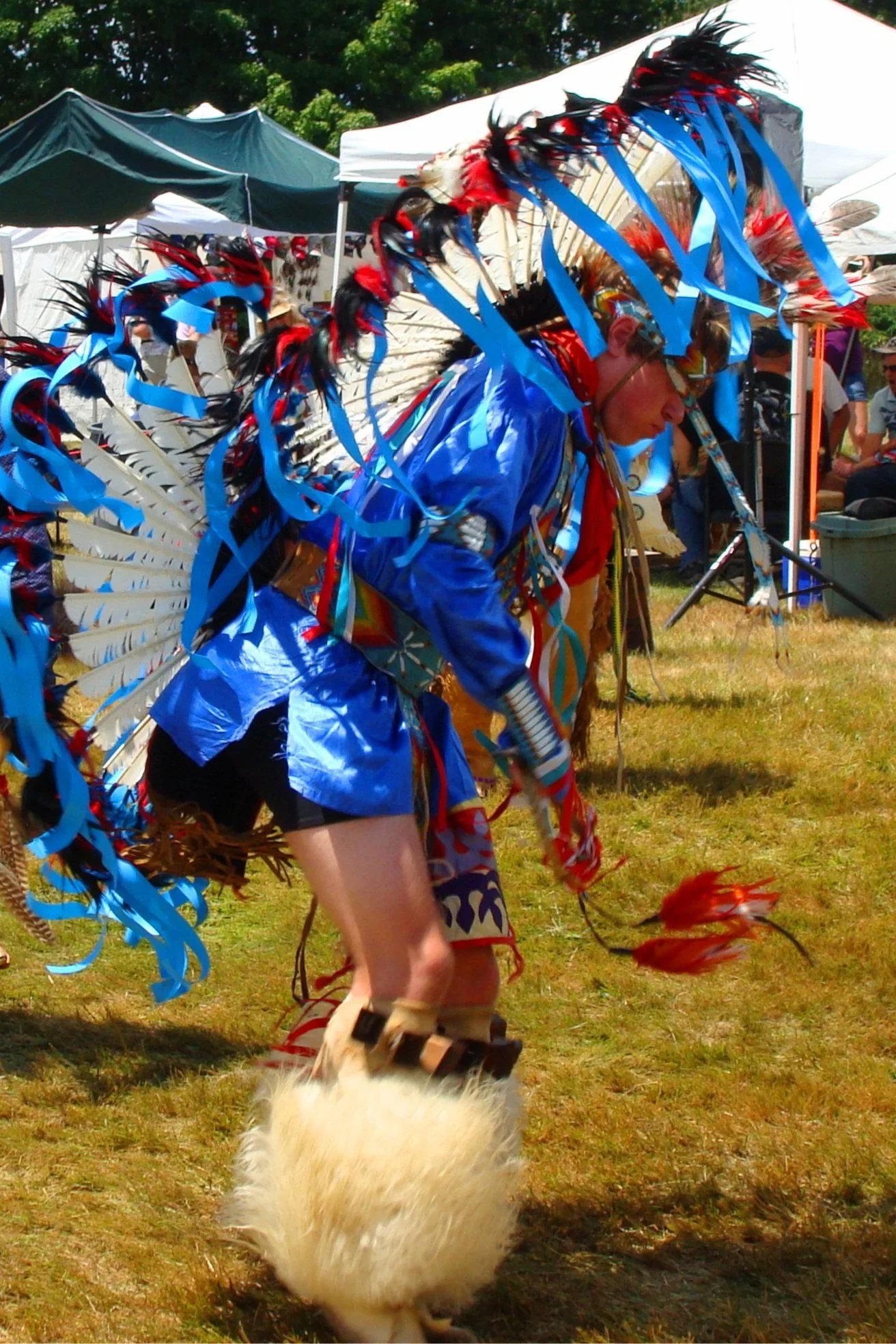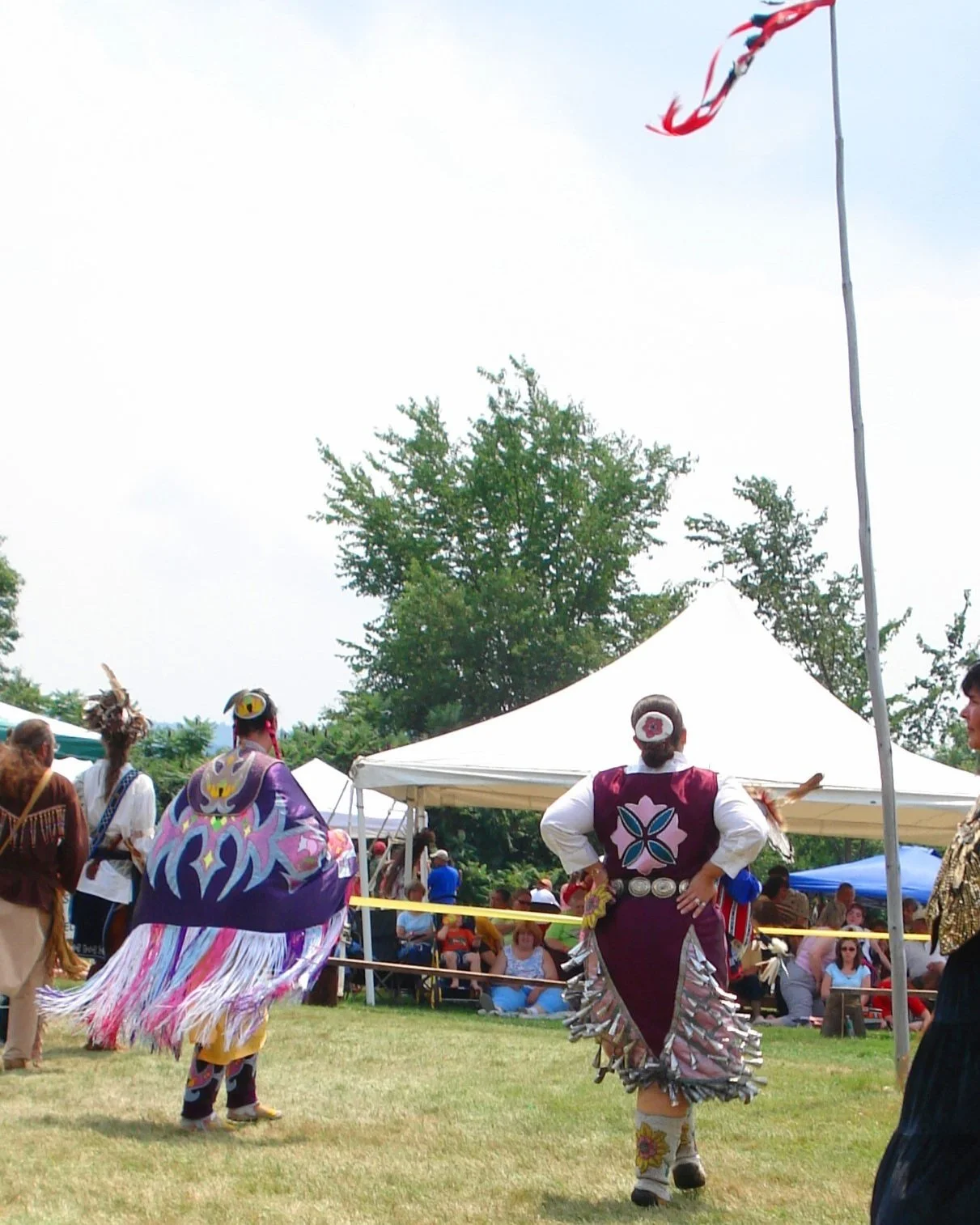Virtual Program
Please see below for our virtual program which will keep you informed for all things Powwow! Don’t forget, the museum is also open to explore all of our amazing exhibits, the Medicine Woods are perfect for a quiet walk and reflection, and there are amazing Silent Auction items to bid on at the MKIM tent. Enjoy!
Flier and tee shirt design by Shellie Channell
2024 Head Staff
Host Drum:
Blackstone Valley Singers
Invited Drums:
Black Thunder Singers, Iron River Singers, Walking Bear Singers
MC:
Ed Bullock (Saturday)
Ernie Proper (Sunday)
Head Dancers:
Nicole Johnson, Penobscot Nations
Samuel Oser, Passamaquoddy
Arena Director:
Albert Caron
Head Veteran:
Takara Matthews-Hansell
Schedule of Events
Saturday July 13, 2024
10 am . . . Gates Open on Powwow Field, Museum open for Self Guided Tours
10 am . . . Story Telling with Willow Greene in Contemporary Art Gallery
11 am . . . Sensory Friendly Educational Session in Powwow Circle
12 pm . . . Grand Entry at Powwow Circle - Grand Entry Song, Flag Song, Veteran's Song
3 pm . . . Story Telling with Willow Greene in Contemporary Art Gallery
5 pm . . . End of Session, Museum closed
5:30 pm . . . Participant Feast Served at Circle
_________________
Sunday July 14, 2024
10 am . . . Gates Open on Powwow Field, Museum open for Self Guided Tours
10 am . . . Story Telling with Madeleine Wright in Contemporary Art Gallery
11 am . . . Regalia and Dance Orientation in Powwow Circle
12 pm . . . Grand Entry at Powwow Circle - Grand Entry Song, Flag Song, Veteran's Song, Sweetheart Special
3 pm . . . Story Telling with Madeleine Wright in Contemporary Art Gallery
4 pm . . . End of Session - Retire Colors, Museum closed
*Please note that while leashed pets are welcome on museum grounds,
we ask that you do not leave them in your car. Thank you.
We hope you are thoroughly enjoying our 23rd Annual Powwow at the Mt. Kearsarge Indian Museum! Your presence and participation are what make this event so special. As we strive to continuously enhance our offerings and support for Native American culture and community, your feedback is invaluable. This short survey will take just a few minutes to complete and will greatly assist us in shaping future events and exhibits. We truly appreciate your time and insights!
-
Tips and Guidelines to ensure the best experience at ensure a respectful and enjoyable experience for yourself and fellow attendees, while fostering a welcoming and inclusive environment for all.
The MC will explain events during the Powwow including when to stand and sit after honoring songs. He will also announce intertribal dances and other important information
Please ask Singers and Dancers before taking their photos. If the MC announces that no photos are to be taken, please respect this request. An MC will make this request during a sacred honor song or dance. We ask that you respect this very important part of our Native tradition.
Do not sit on someone else's blanket unless you are invited. Please note benches within the circle are reserved for the Dancers and Elders should receive preference in seating under the tent.
If invited to dance, please do so. It is disrespectful to decline. If you do not know how, you will be taught by the person who invited you.
Please do not refer to a Dancer's attire as a "costume". The preferred term is regalia. Regalia is sacred to that dancer, often passed down through a family or given to honor someone. A dancer's regalia is an important part of his or her identity and culture.
Do not touch a dancer's regalia. These items are often handmade and are often gifts to the dancers from friends and family. They have deep significance and should be treated with reverence.
Questions are welcome. Please ask!
Powwow Players and Roles
Drum Styles
The songs sung by the drums at the Powwow are an integral part of Native culture. Many of the songs today use vocables instead of words. Since many of the Powwows in the area are Intertribal (attended by singers and dancers from tribes throughout the US and Canada), vocables are sometimes used to avoid offending those who may not know the language it was originally performed in. In other cases, the original words have been lost to time and only the notes have been passed down through the generations. Within the songs, there are a series of loud beats referred to as honor beats. In some traditions, these beats represent gunshots and are placed to honor warriors and ancestors that have gone before us. Each song begins with the lead singer starting the song (or a lead) and he is echoed by the rest of the drum. The song is repeated four to six times and each repetition is referred to as a push-up. While women do not sit at the drum in most traditions, they will often stand behind the men where they sing an octave higher and their voices can carry above and complement the deeper tones of the drum and the men singers.
Southern Singing
Southern singers have songs based in the area around Oklahoma and the southern parts of the US. The lower pitch of their songs sets them apart from Northern singers, as well as the three honor beats in the middle of their push-up. Southern songs will often end with five loud beats.
Northern Singing
Northern songs originated from the Great Plains and Great Lakes regions of the US and Canada. They are identified by a higher pitch than the Southern style and will place Honor Beats in the second half of the push-up. The song is most often ended with three loud beats.
MC
The MC is the voice of the Powwow. Throughout the day, the MC annouunces activities taking place all over the Powwow grounds, as well as information regarding dance styles and arbor protocols. The MC confers with the host drum and announces the dances and also filters all requests for honoring or special dances and songs to ensure the smooth pace of the Powwow.
Head Dancers
Head Dancers are selected one year in advance of the Powwow. During that year, the Dancers will prepare a giveaway to acknowledge the honor they have received. Responsibilities during the Powwow include starting every dance or waving participants on to start without them and escorting special guests within the circle. No dancer may start dancing before the Head Dancers.
Arena Director
The Arena Director is in charge of maintaining the circle for dancing. The Arena Director will help dancers get in order for Grand Entry and settle any disputes within the circle. Throughout the weekend, the Arena Director will also ensure that all dancers are dressed appropriately and being respectful within the circle.
Head Veteran
Native Americans traditionally have a high level of military enlistment compared to the general US population and when choosing a Head Veteran, it must be someone with a military background. The Head Veteran ensures that the Eagle Staff and flags are cared for during Grand Entry and when retiring the flags at the end of the session. They will also pick up any eagle feathers that have fallen on the dance floor as they represent fallen warriors wounded in battle and will lend their experience and knowledge should difficult decisions arise during the Powwow.
Dance Styles
Northern Traditional
Northern Traditional men are adorned in traditional style regalia with beaded vests. breechcloths, leggings, and a single circular bustle of eagle feathers on the back. This is a style of dance evolved from the old form of the war dance, where the dancer recreates a war story or hunting expedition through dance. A dancer may carry shields, weapons, staff, medicine wheel, or a fan (all symbols of warrior status). The regalia incorporates the old traditional elements of color with beadwork, quillwork, featherwork, and ribbonwork to identify a dancer’s particular tribe, clan, or status. In this category, many versions of traditional regalia will reflect the region of tribal origin as well as personal taste.
Southern Traditional
Dancers may wear cloth regalia with ribbons, beads, and silverwork which would have traditionally been obtained in trade and adapted to suit the tastes and styles of her tribe. Most traditional women dancers carry a fan of eagle, hawk, or other feathers, a purse, and a shawl. The use and adaptation of new materials to express Native identity is an ongoing process. Modern Southern Traditional dancers incorporate elaborate ribbon work and applique designs or intricate beadwork. It is also common to see Southern dancers wear a beaded crown with a single eagle plume in it. The dance is characterized by elegance, poise, and a slight bowing at the honor beats.
Eastern War
This is a contemporary version of an old style Eastern War Dance, which is one of the oldest dances still practiced in its original form. In times of war, the warriors would gather at the center of the village, or in winter they would gather in the long house. There, a fire would be burning and a pole in the center of the ring would represent the enemy. The warriors would stand around the outside of the dance circle with their feet stomping hard to the beat of the drum and the rattle and would create a story in their dance that would imitate a battle with the enemy to prepare them for battle. .
Jingle
The jingle dress is well known in Native circles as a gift from the Creator to the Native people for the purpose of healing. The dress features tiers of jingle cones which were originally made of metal lids from tobacco tins and are now available in a wide variety of materials. The cones are attached to ribbons and sewn onto dresses often decorated with applique designs. Matching beaded moccasins, barrettes, and other accessories are also common. More contemporary dancers will wear eagle or other feathers in their hair and carry a fan which is raised during honor beats. Old style jingle dancers will not wear plumes or carry a fan. While the contemporary jingle dance is fast paced and exhibits intricate, controlled footwork, the steps in old style jingle are slower and closer to the ground.
Fancy Bustle
This dance is marked by the elaborate and brilliantly colored regalia of the dancers and wild free-style movements. The dancers are easily identifiable by the double bustles on their backs. Very often, handheld dance sticks are twirled in time to the drum and the two feathers that top the roach are kept in a constant rocking motion by head movement. Dancers are known for the intricacy of their footwork combinations with emphasis on style and agility. This dance should reflect pride and the aggressive movements of warriors.
Northern Traditional
This is an elegant dance; a slow, graceful walk and gentle sway in time to the music of the drum. The gentle motion of the fringed shawl folded over the arm must be in harmony with the motion of the body and with the drumbeat. Dresses are decorated with many small tin cones near the hem of the dress and tin tubes on the beaded pouches that decorate the belt, which produce a gentle tinkling sound. Beautiful (and heavy) breastplates and chokers made of bone and crystal beads, intricately beaded medallion necklaces, purses, buckskin moccasins, and leggings are traditional. Women will often carry a fan and wear beaded barrettes and eagle plumes in their hair. .
Southern Straight
Regalia worn by the Southern Straight dancers is often formal, tailored, and prestigious. Accordingly, the slow and proud movement of the dance style matches this attire. This is a “Gentlemen’s” dance, which tells the story of a hunting or war party on the trail of an animal or an enemy. Both the dance and the regalia are known for the subtle details. Aprons and shirts are elaborately decorated with ribbonwork, while beaded medallions or silver discs add an elegant touch. A single eagle father often sits atop a porcupine roach or otter turban. Straight dancers move smoothly, with precision, and with a powerful sense of pride.
Northeast Woodlands
There are as many variations on this style of dress as there are individuals. The origin of each piece and its use also varies from tribe to tribe but many pieces have originated from the tools that women carried and used most often in their daily work such as awl cases, knife pouches and even straps used as horse whips or to bundle and carry things. Strap dresses of wool or cloth are often decorated with beading, quillwork, or ribbons. Beaded wrap skirts may be worn with a loose shirt and trade silver brooches. The colors for this dance tend to be more subdued than in other outfits.
Grass
Long ago, the dancers wore outfits that were made solely with the natural materials that were available, such as grass, porcupine quills, and hair. Today’s dancers will still incorporate these items in their outfits, adding ribbons, yarns, and bells. The dancer uses skillful movements to resemble the gentle swaying of grass on a windy day, while simulating the preparation of a traditional dance circle by flattening large sections of prairie grass by matting it with his feet. The regalia is characterized by colorful beadwork or applique, belt, cuffs, headband, and harness with a porcupine roach and two feathers in spinners. The feathers are kept in constant motion in harmony with the drum and song and dance steps should be equally balanced on the left and right.
Fancy Shawl
The fast pace and distinctive brightly colored shawl epitomize the fancy shawl dance. Materials such as sequins, ribbon, and fabric are combined with beadwork, quills, and feathers to create this elaborate regalia. The fancy shawl dance is a combination of intricate footwork and spins to create a constant whirl of beauty and grace (rather than wild movements), with no small measure of endurance and agility. The movements and colorful regalia of a fancy shawl dancer are often compared to those of a butterfly.
Volunteers
Thank you to all of the volunteers who have donated their time and effort to make this powwow come to life. An average of 300 hours of volunteer time is donated during the powwow weekend, in addition to the efforts of the powwow committee who work on the planning and set up throughout the fall, winter, and spring. Two important traditions of a powwow are those of giving and sharing. The giving of time and sharing of talents is what helps make this powwow a success. Many thanks to all!
Interested in joining our amazing group of volunteers?
Fill out the form below!
2024 Powwow Committee
Katie Devoid, Chairperson
Natalie Breen
Trevor Breen
Andy Bullock
Carolyn Bullock
Chris Bullock
Ed Bullock
Erik Bullock
Al Caron
Deb Caron
Scott Devoid
Bob Durand
Anna Glavas
Jill Gross
Jackie Lantagne
Sponsors and Supporters of the 2024 MKIM Powwow








A very special thanks…
The Powwow Committee would like to take this opportunity to extend our gratitude to those companies and individuals who have helped support the powwow through their generous contributions. Thank you to Mascoma Bank and Surface Creations of Vermont for their Platinum Level Sponsorship. Thank you to Sugar River Bank for their Silver Level Sponsorship. And thank you to Al and Debbie Caron, Bob Durand, Jill Gross, Mel Howarth, Paige Oristano, The Wandering Bull, LLC, The Little Bull, LLC, and Chemtan for all of their generous donations. The Mt. Kearsarge Indian Museum is also supported in part by a grant from the New Hampshire State Council on the Arts and the National Endowment for the Arts. And of course, we wouldn’t be able to keep our doors open without the support of our membership and the local community who come out to all of our events. Thank you!
